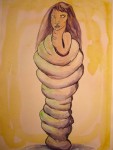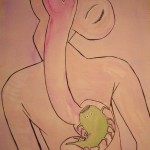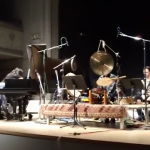So finally I am recording Zozimos. Even though my aspirations for this group are unlimited, time and money are, so I’ve decided to focus this group as a Quintet with guests that have been apart of Zozimos. The quintet is: Justin Wood, Danny Fischer, David Smith and Sebastian Noelle. The guests so far are: Alex Terrier, Andy Hunter, Amanda Brasher, Curtis Stewart and Isaac Darche. This is a very exciting project for me. To make sure the group will be peaking for the recording we’ve managed to line up 3 concerts between now and the recording. The first one is tomorrow (Feb 2nd) 11:45 at Goodbye Blue Monday, the second one is at the Shrine, opening up for the Shrine Big Band on Super Bowl Sunday at 8pm and the last one before our weekend of recording is at a venue that is a personal favorite of mine, La Terraza Cafe (7 Train Bar), Feb 9th, opening up for Alejandro Florez’s Quartet, which I am also playing in with Daniel Blake and Yayo Serka. That show will start at 8pm and each group will play a set. Please come out and show some support. All of the shows are free.
Zoz Files – excerpts from Panopolis(2)
 Looking out from the Nicaraguan coast Zozimos sees a leatherback sea turtle hide it’s eggs. The locals told him that they can get to be 9 feet long head to toe and up to 2000 lbs. Apparently the eggs take 45 days to hatch, 90% of the children die during their exploration into the deep seas. When they finally return it has been 15 years and they manage to find the exact place where they were born, despite the fact that their travels can take them on 20,000 mile long journeys.
Looking out from the Nicaraguan coast Zozimos sees a leatherback sea turtle hide it’s eggs. The locals told him that they can get to be 9 feet long head to toe and up to 2000 lbs. Apparently the eggs take 45 days to hatch, 90% of the children die during their exploration into the deep seas. When they finally return it has been 15 years and they manage to find the exact place where they were born, despite the fact that their travels can take them on 20,000 mile long journeys.
The two statistics that caught Zozimos’ attention was the ones that did not vary, that the eggs take exactly 45 days to hatch and that it takes them exactly 15 years to return home. Both numbers are multiples of 5.
On the balcony of the luxurious restaurant looking over the Chococente beach Zozimos partakes in some aguardiente to sooth his full belly. He just finished the delicacy that is the leatherback sea turtles’ eggs.
Again he contemplates: why the number 5?
One nest of eggs costs a third of an average monthly income. Returning the glass of aguardiente back to the table, with his fingers he curiously shuffles through the remains of his meal -a meal made from a beast that has survived 110 million years and is now on the ‘critically endangered’ list of species.
What is in the number 5?
As he continues to move his fingers about the scraps of his meal, he notices that the number 5 also pervades his own existence. 5 appendages from the torso, 5 appendages from each limb, 5 openings in the face, 5 major organ systems according to Chinese medicine, and most pervasive: his 5 very own and unique senses.
– Ch. 2, verse LV
Comments Off on Zoz Files – excerpts from Panopolis(2)
Posted in Zoz Files
Zoz Files – Excerpts from Panopolis
 Going back into his deep slumber he remembers a large house with loved ones stationed at different parts of the edifice. His favorite most cherished one lays on the ground in front of him infected with what at first glance seems to be some disfiguring disease. It appears that a creature, green in hue has symbiotically attached itself to the gory aftermath that only faintly resembles the victim. He packages the half-dead body into a box, haphazardly poking and ripping at the green parts inside, hoping he might kill what is still alive, and then hides the box. He wants to forget what he saw and decides to wake himself.
Going back into his deep slumber he remembers a large house with loved ones stationed at different parts of the edifice. His favorite most cherished one lays on the ground in front of him infected with what at first glance seems to be some disfiguring disease. It appears that a creature, green in hue has symbiotically attached itself to the gory aftermath that only faintly resembles the victim. He packages the half-dead body into a box, haphazardly poking and ripping at the green parts inside, hoping he might kill what is still alive, and then hides the box. He wants to forget what he saw and decides to wake himself.
– Ch. 10, verse IX
 The doctor explains that what is inside of him must be removed. At this stage it has grown to be too large and aggressive and oral medication will not help to purge the creature from within. The operation is risky and he is scared to go through with it. He wakes for a brief moment and realizes he is only dreaming but still feels a pain in stomach where the imaginary creature would have been. So to resolve the dream and wake without an imaginary creature inside he closes his eyes. The operation was successful although it hurts to laugh. As he gets off the operating table he sees two small, fat baby worms crawl into the crevices of the rundown wooden walls. He tell the doctor that her operation was sloppy and she should of killed the baby worms as well or one might have crawled into his mouth while he was sleeping. He then wakes knowing that didn’t happen.
The doctor explains that what is inside of him must be removed. At this stage it has grown to be too large and aggressive and oral medication will not help to purge the creature from within. The operation is risky and he is scared to go through with it. He wakes for a brief moment and realizes he is only dreaming but still feels a pain in stomach where the imaginary creature would have been. So to resolve the dream and wake without an imaginary creature inside he closes his eyes. The operation was successful although it hurts to laugh. As he gets off the operating table he sees two small, fat baby worms crawl into the crevices of the rundown wooden walls. He tell the doctor that her operation was sloppy and she should of killed the baby worms as well or one might have crawled into his mouth while he was sleeping. He then wakes knowing that didn’t happen.
– Ch. 57, verse CCXLV
Comments Off on Zoz Files – Excerpts from Panopolis
Posted in Zoz Files
Zozimos Collective Show @ Roulette 11.28.11
Eight Houses is based on the I-Ching’s Ba Gua and 6 double Trigrams (hexagrams). The Ba Gua has been popularized by such TV shows as Lost, found on the Dharma Initiative’s Seal. Some of the Eight Trigrams from the Bagua are found also on the Korean, Sri Lankan and Vietnamese flags.
At the heart of the I-Ching is the Ba Gua which actually is an elaboration of the concept of Yin and Yang, opposing yet complimentary forces. The trigrams are symbols that represent different permutations of Yin-Yang. An unbroken line represents Yang and a broken line represents Yin. So a trigram with 3 unbroken lines would be the ultimate pure Yang energy.
The Eight trigrams that form the Ba Gua are the following (paired as opposing/contrary forces, like Yin and Yang): Earth – Heaven, Fire – Water, Wind – Thunder and Lake – Mountain. There are two arrangements of the Ba Gua, one is a more abstract, universal arrangement that orders them by opposites. This arrangement is used in Feng Shui for ancient burial sites among other things. King Wen’s arrangement is the more practical ordering which is used in Feng Shui for design and also, it is this arrangement that is used primarily for describing relationships in the I-Ching. This arrangement also describes the cycle of life, the seasons and compass points:
Thunder/Arousing – causes the primal energies that create, Wind is an inexorable force that forms the building blocks of life, like DNA or the shape of a mountain, Fire is the moment that a seed sprouts and starts growing towards the sun, it is also the moment that perception is born between people, the moment Adam and Eve noticed they were both naked, Earth is the the purest Yin energy that nurtures and yields to support and sustain life, the Lake/Joyousness/Stagnation is when plants blossom and mankind can enjoy the fruits of their labor, Heaven, the purest Yang energy is when forces of light and dark begin to battle and ultimate creation takes place, Water/Abyss is the winter months when animals hibernate and for humans, it is when there are trying times. And out of this energy there is the Mountain/Stillness when things come to an end and also when things begin. It is a moment of meditation and stillness.
The movements in Eight Houses have been ordered to represent for me the description above. The only pure formula (serialization) I used in composing this piece was from my own theory of harmony, micro-functional tonality, which I’ve been using for awhile now in all of my pieces. I did not come up with a one-to-one analogous relationship between the hexagrams and trigram and
music in terms of tonal centers or rhythms. I also did not use chance to decide or determine any parts of the composition. In one section I did use a clave based on hexagram 15, entitle Enthusiasm. This clave provides a driving force for the 3rd movement: Fire. In it’s entirety this piece seeks to artistically represent the basic building blocks/energies that make up the I – Ching.
Musicians:
I would like to give a big thank you to all of the musicians and the staff at Roulette for inspiring me and making this concert possible.
Comments Off on Zozimos Collective Show @ Roulette 11.28.11
Posted in shows
MusicEd – Intro to Chords
Here is a beginner’s intro to chords.
It goes through the basics:
1. Identify notes and notes with accidentals on the piano 2. Interval recognition (major and minor 2nds) 3. Major Scale Pattern 4. Major Scales/Degrees of Scales 5. Chord formulas
What to do:
1. Learn to identify the notes on the piano
2. Learn to identify major and minor 2nds on the piano
3. Apply the major scale pattern of major and minor 2nds starting on different notes.
4. Number each scale. example: in C major C=1, D=2, E=3, F=4, G=5, A=6 and B=7
5. Each chord is a combination of scale degrees. example: Augmented = 1 3 #5
6. Not mentioned on this sheet is exercises that make you name the notes of different chords. So here is a follow up:
7. Bb augmented, C half-diminshed, B minor7, A dominant7, Db full-diminshed
MusicEd – Transcriptions
Here are some transcriptions I did a couple years back.
I feel transcribing can be good for simply identifying on paper and conceptually what you are hearing. Sometimes we hear something and think we know what it is. That ability for me (although I still suck at it) took time and transcribing solos helped me hone this skill. The process of transcribing can be fortuitous simply by honing your perception skills as a listener.
The tenor solos are in alto cleff because I wanted to write in concert pitch and didn’t want so many ledger lines. It is annoying to read, but getting better at alto cleff can help when dissecting string quartets.
However, transcribing doesn’t mean you will sound like what you are transcribing. That feature is a technical battle and many hours of practiced are needed to acquire the muscle memory necessary for execution of said material. As a soloist, I must admit, I do not sound like any of the soloists below, and that is because I don’t practice the material. I do like the solos and I transcribed because I wanted to know why I liked them and why they sound the way they do.
- Mark Turner
- Charlie Parker
- Tom Harrell
- Sonny Stitt
- Sonny Rollins
- Jesus Santandreu
- Pepper Adams
- Donald Byrd
Possible song titles for new CD
Comments Off on Possible song titles for new CD
Tagged haha
Jan 5th – Chia’s Dance Party @ Zinc Bar 8pm
On Thursday, January 5th Chia’s Dance Party will be promoting our album “La Miel” with a set at the Zinc Bar also in the West Village (8:00 – 9:00 PM). This quintet performs an energetic mix of Colombian folkloric rhythms and contemporary jazz harmony concocted by drummer Martin Vejarano. This special performance will also feature the trombone of Andy Hunter, Ben Stapp (tuba) and Alex Terrier (soprano sax).
There’s a small cover for each of these, but they’re specifically designed to be accessible to the 99% (i.e., it’s around $10). We’d be honored to have you there.
[google-map-v3 width=”350″ height=”350″ zoom=”12″ maptype=”ROADMAP” mapalign=”center” latitude=”0″ longitude=”0″ addresscontent=”82 West 3rd Street, NY” showmarker=”true” animation=”DROP” maptypecontrol=”true” pancontrol=”true” zoomcontrol=”true” scalecontrol=”true” streetviewcontrol=”true” bubbleautopan=”false” markerdirections=”true” showbike=”false” showtraffic=”false” showpanoramio=”false”]
benstapp.com Moved to WordPress
Comments Off on benstapp.com Moved to WordPress
Tagged news

